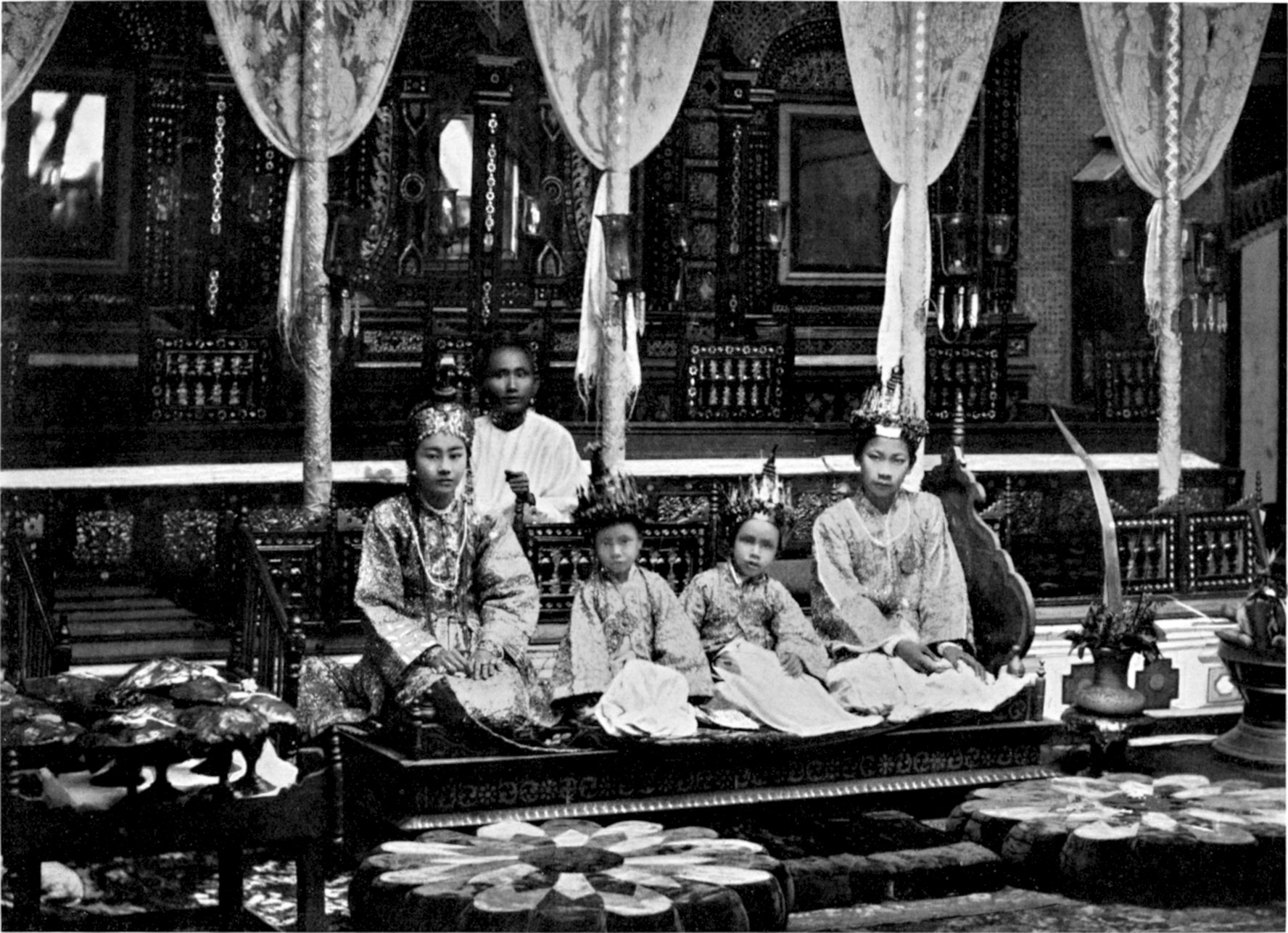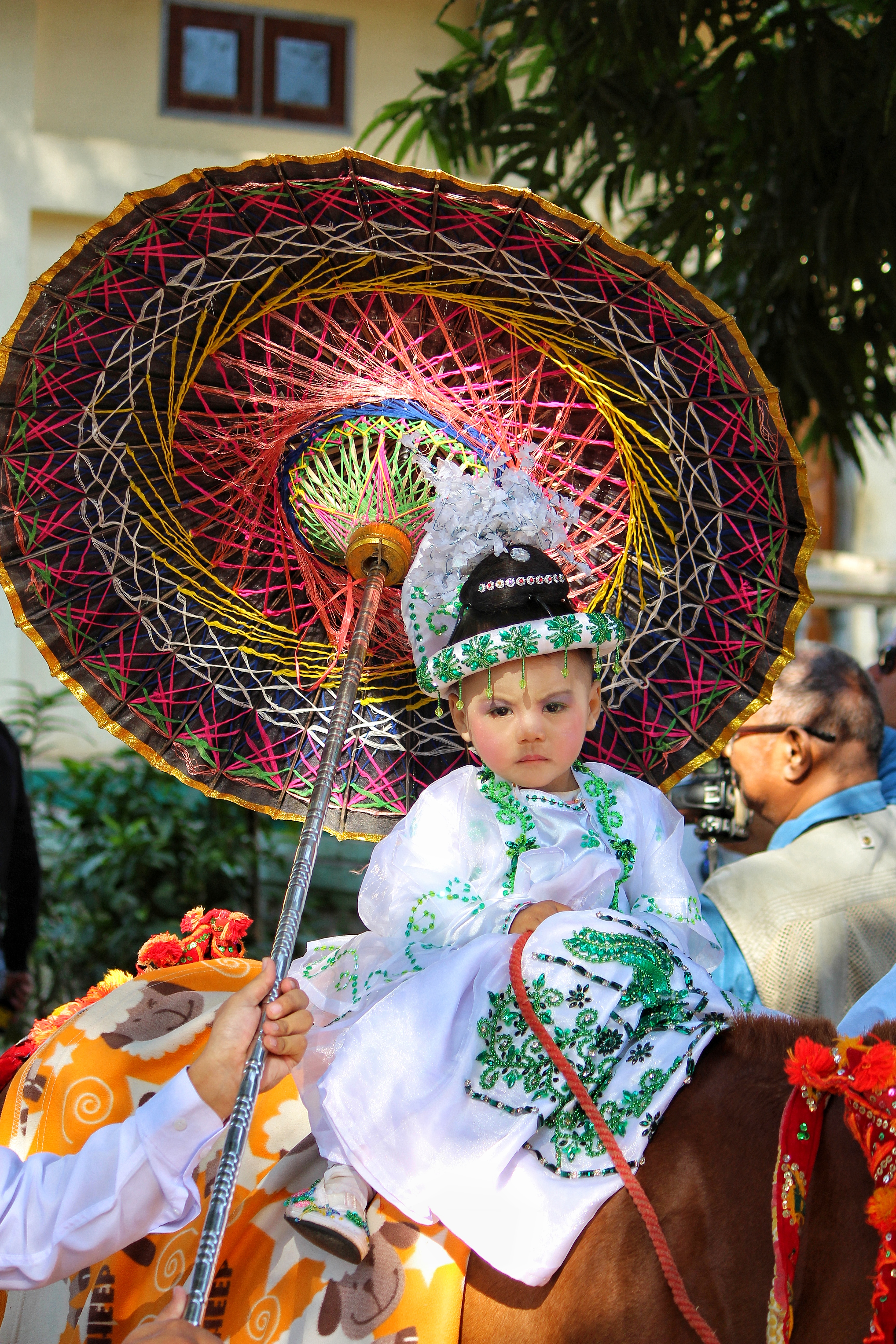Twelve Auspicious Rites on:
[Wikipedia]
[Google]
[Amazon]
 The Twelve Auspicious Rites ( my, လောကီမင်္ဂလာဆယ့်နှစ်ပါး, , and ) are a series of worldly
The Twelve Auspicious Rites ( my, လောကီမင်္ဂလာဆယ့်နှစ်ပါး, , and ) are a series of worldly
 # () – the successful delivery of a child
# () – the taking of refuge in the
# () – the successful delivery of a child
# () – the taking of refuge in the
 The Twelve Auspicious Rites ( my, လောကီမင်္ဂလာဆယ့်နှစ်ပါး, , and ) are a series of worldly
The Twelve Auspicious Rites ( my, လောကီမင်္ဂလာဆယ့်နှစ်ပါး, , and ) are a series of worldly rites of passage
A rite of passage is a ceremony or ritual of the passage which occurs when an individual leaves one group to enter another. It involves a significant change of status in society. In cultural anthropology the term is the Anglicisation of ''rite ...
recognized in traditional Burmese culture
The culture of Myanmar (also known as Burma) ( my, မြန်မာ့ယဉ်ကျေးမှု) has been heavily influenced by Buddhism. Burmese culture has also been influenced by its neighbours.
In more recent times, British colonial ...
, particularly by the Bamar
The Bamar (, ; also known as the Burmans) are a Sino-Tibetan ethnic group native to Myanmar (formerly Burma) in Southeast Asia. With approximately 35 million people, the Bamar make up the largest ethnic group in Myanmar, constituting 68% of th ...
. These are distinct from the Thirty-eight Buddhist Beatitudes described in the Maṅgala Sutta
The ' is a discourse (Pali: '' sutta'') of Gautama Buddha on the subject of 'blessings' (''mangala'', also translated as 'good omen' or 'auspices' or 'good fortune'). In this discourse, Gautama Buddha describes 'blessings' that are wholesome p ...
.
In modern times, only four or five of these rites — the naming, first feeding, ear-boring, shinbyu
Shinbyu (; , also spelt shinpyu) is the Burmese term for a novitiation ceremony ( pabbajja) in the tradition of Theravada Buddhism, referring to the celebrations marking the sāmaṇera (novitiate) monastic ordination of a boy under the age of ...
, and wedding rites — are commonly practiced in Myanmar, especially in urban cities. In pre-colonial Burma, Brahmins
Brahmin (; sa, ब्राह्मण, brāhmaṇa) is a varna as well as a caste within Hindu society. The Brahmins are designated as the priestly class as they serve as priests (purohit, pandit, or pujari) and religious teachers (guru o ...
typically consecrated or led these rites. Today, masters of ceremony who specialize in abhisheka
Abhisheka () means "bathing of the divinity to whom worship is offered." It is a religious rite or method of prayer in which a devotee pours a liquid offering on an image or murti of a God or Goddess. Abhisheka is common to Indian religions su ...
rituals, called ''beiktheik saya'' (ဘိသိက်ဆရာ), consecrate these rites. ''Beiktheik saya'' derive their skills from four Vedic scriptures
upright=1.2, The Vedas are ancient Sanskrit texts of Hinduism. Above: A page from the '' Atharvaveda''.
The Vedas (, , ) are a large body of religious texts originating in ancient India. Composed in Vedic Sanskrit, the texts constitute th ...
, namely Sāmaveda, Yajurveda
The ''Yajurveda'' ( sa, यजुर्वेद, ', from ' meaning "worship", and ''veda'' meaning "knowledge") is the Veda primarily of prose mantras for worship rituals.Michael Witzel (2003), "Vedas and Upaniṣads", in ''The Blackwell C ...
, Atharvaveda
The Atharva Veda (, ' from ' and ''veda'', meaning "knowledge") is the "knowledge storehouse of ''atharvāṇas'', the procedures for everyday life".Laurie Patton (2004), Veda and Upanishad, in ''The Hindu World'' (Editors: Sushil Mittal and G ...
, and Rigveda
The ''Rigveda'' or ''Rig Veda'' ( ', from ' "praise" and ' "knowledge") is an ancient Indian collection of Vedic Sanskrit hymns (''sūktas''). It is one of the four sacred canonical Hindu texts (''śruti'') known as the Vedas. Only one Sh ...
, in addition to Pali scriptures.
List of rites
 # () – the successful delivery of a child
# () – the taking of refuge in the
# () – the successful delivery of a child
# () – the taking of refuge in the Three Jewels
In Buddhism, refuge or taking refuge refers to a religious practice, which often includes a prayer or recitation performed at the beginning of the day or of a practice session. Since the period of Early Buddhism until present time, all Theravada ...
, worship of the Nandimukha nat
Nat or NAT may refer to:
Computing
* Network address translation (NAT), in computer networking
Organizations
* National Actors Theatre, New York City, U.S.
* National AIDS trust, a British charity
* National Archives of Thailand
* National As ...
, and paying of obeisance to a child's grandparents
Grandparents, individually known as grandmother and grandfather, are the parents of a person's father or mother – paternal or maternal. Every sexually-reproducing living organism who is not a genetic chimera has a maximum of four genetic gra ...
on the third day of a child's birthAlso called ().
# () – the shaving of a child's hair on the 7th day of a child's birth
# () – the first cradling of a child on an auspicious day"" (ဒေါလာ) is sometimes misspelt (ဒေါဠာ).
# () – the first ceremonial feeding of betel nut
The betel (''Piper betle'') is a vine of the family Piperaceae, which includes pepper and kava. The betel plant is native to Southeast Asia. It is an evergreen, dioecious perennial, with glossy heart-shaped leaves and white catkins. Betel plan ...
(flavored with catechu
( or ) is an extract of acacia trees used variously as a food additive, astringent, tannin, and dye. It is extracted from several species of ''Acacia'', but especially ''Senegalia catechu'' (''Acacia catechu''), by boiling the wood in wate ...
, licorice
Liquorice (British English) or licorice (American English) ( ; also ) is the common name of ''Glycyrrhiza glabra'', a flowering plant of the bean family Fabaceae, from the root of which a sweet, aromatic flavouring can be extracted.
The liq ...
, and fennel
Fennel (''Foeniculum vulgare'') is a flowering plant species in the carrot family. It is a hardy, perennial herb with yellow flowers and feathery leaves. It is indigenous to the shores of the Mediterranean but has become widely naturalized ...
seeds) to a child, on the 75th or 100th day of a child's birthAlso called (). Now sometimes replaced with (), the child's first ceremonial hair-washing as betel nut has fallen out of common use.
# () – the first revealing of a child to the sun and moon on the full moon
The full moon is the lunar phase when the Moon appears fully illuminated from Earth's perspective. This occurs when Earth is located between the Sun and the Moon (when the ecliptic coordinate system, ecliptic longitudes of the Sun and Moon opp ...
day of the first, second, or third Burmese lunar months following a child's birth
# () – the naming of a child based on a child's personalized horoscope (ဇာတာ) on the 100th day of a child's birth, similar to the Hindu namakarana ceremony
# () – the first ceremonial feeding of solid food (steamed rice) to a child, also commemorated with the donation of food alms
Alms (, ) are money, food, or other material goods donated to people living in poverty. Providing alms is often considered an act of virtue or Charity (practice), charity. The act of providing alms is called almsgiving, and it is a widespread p ...
to Buddhist monks
A ''bhikkhu'' (Pali: भिक्खु, Sanskrit: भिक्षु, ''bhikṣu'') is an ordained male in Buddhist monasticism. Male and female monastics ("nun", ''bhikkhunī'', Sanskrit ''bhikṣuṇī'') are members of the Sangha (Buddhist c ...
, on the 6th month of a child's birthAlso called (အာဟာရပရိဘောဂမင်္ဂလာ, ) or (, ).
# () – the hair-knotting of a child, after the hair is shampooed with traditional herbal shampoo made with soap acacia and ''Grewia elastica'' ( Tayaw kinbun) on an auspicious day
# () – the ear-boring ceremony of a child an auspicious day
# () – shinbyu
Shinbyu (; , also spelt shinpyu) is the Burmese term for a novitiation ceremony ( pabbajja) in the tradition of Theravada Buddhism, referring to the celebrations marking the sāmaṇera (novitiate) monastic ordination of a boy under the age of ...
, the ordination of a child into the Buddhist monkhood as a samanera
A sāmaṇera (Pali); sa, श्रामणेर (), is a novice male monastic in a Buddhist context. A female novice is a ''śrāmaṇerī'' or ''śrāmaṇerikā'' (Sanskrit; Pāli: ''sāmaṇerī'').
Etymology
The ''sāmaṇera'' is a ...
on an auspicious dayAlso called (သာမဏေရပဗ္ဗဇ္ဇမင်္ဂလာ).
# () – the wedding ceremony
A wedding is a ceremony where two people are united in marriage. Wedding traditions and customs vary greatly between cultures, ethnic groups, religions, countries, and social classes. Most wedding ceremonies involve an exchange of marriage vo ...
on an auspicious dayTypically combined with the (ဝိဝါဟမင်္ဂလာ), the rite wherein the daughter is led to her family home before the wedding.
The scholar Aung Chein also identifies a number of auspicious rites outside of the twelve listed above:
# () – the first touching of the ground by a child
# () – the first parting of the child's hair by his or her mother
# () – the wearing of the makuṭa
The ( sa, मुकुट), variously known in several languages as ''makuta'', ''mahkota'', ''magaik'', ''mokot'', ''mongkut'' or ''chada'' (see below), is a type of headdress used as crowns in the Southeast Asian monarchies of today's Cambodia ...
crown
# () – the housewarming
A housewarming party is a party traditionally held soon after moving into a new residence. It is an occasion for the hosts to present their new home to their friends, post-moving, and for friends to give gifts to furnish the new home. House-warm ...
ceremony
Notes
References
See also
*Awgatha
An ''Awgatha'' (ဩကာသ; from Pali: ''okāsa''), sometimes known as the ''common Buddhist prayer'' is a formulaic Burmese Buddhist prayer that is recited to initiate acts of Buddhist devotion, including obeisance to the Buddha and Buddhist mon ...
* Buddhābhiṣeka
Buddhābhiseka ( pi, buddhābhiseka; sa, buddhābhiṣeka) refers to a broad range of Buddhist rituals used to consecrate images of the Buddha and other Buddhist figures, such as bodhisattvas.
Terms
Buddhābhiseka is known a number of different ...
* Culture of Myanmar
The culture of Myanmar (also known as Burma) ( my, မြန်မာ့ယဉ်ကျေးမှု) has been heavily influenced by Buddhism. Burmese culture has also been influenced by its neighbours.
In more recent times, British colonial ...
* Mingalaba
Mingalaba ( ; variously romanised as mingalarpar, mingalabar, or mingalar par) is the formal Burmese greeting." It is typically accompanied by a slight bow, or more formally, an Añjali Mudrā gesture, wherein the palms are folded together. The p ...
* Shinbyu
Shinbyu (; , also spelt shinpyu) is the Burmese term for a novitiation ceremony ( pabbajja) in the tradition of Theravada Buddhism, referring to the celebrations marking the sāmaṇera (novitiate) monastic ordination of a boy under the age of ...
* Weddings in Myanmar
Weddings in Myanmar, considered auspicious occasions in Burmese culture, reflect various ethnic, religious, and regional traditions. Depending on an individual's family social economic status, personal preferences and titles held, Burmese wedding ...
{{Myanmar topics
Burmese culture
Rites of passage